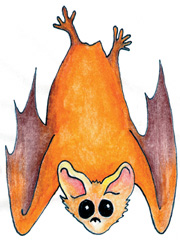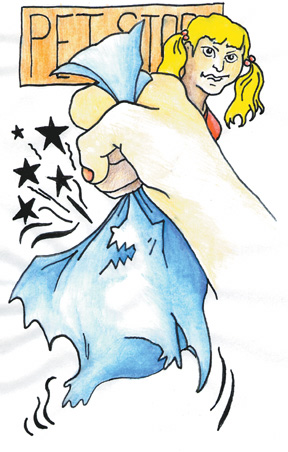
Chesapeake Bay's Independent Newspaper ~ Since 1993
1629 Forest Drive, Annapolis, MD 21403 • 410-626-9888
Volume XVII, Issue 44 ~ October 29 - November 4, 2009
Home \\ Correspondence \\ from the Editor \\ Submit a Letter \\ Classifieds \\ Contact Us
Dining Guide \\ Home & Garden Guide \\ Archives \\ Distribution Locations \\ Advertising
![]()

 Driven Batty
Driven Batty
What to do when Dracula’s little cousin comes calling?
by Mark Burns
Our car swerves to a stop at the curb of a small pet store. I bounce in to meet a teen clerk to whom I offer a grocery bag wadded loosely into the size and shape of a junior soccer ball. The clerk steps back, regarding the gift suspiciously as I hold it over the counter at arm’s length.
“We caught a bat. Do you want it?” I say.
Her eyes widen and twist with her face as she appraises the bag, then me. She shakes her head, No.

The Capture
“Is it still there?”
Bob and I cower at the door to Emily’s room, each hoping the other will investigate the bat situation. Minutes ago, his daughter, my niece, fled downstairs with shrill news. She’s now sheltered safely behind closed doors with her mom.
Bob goes first. He is her father.
The bat sleeps, suspended from twinkle lights above Emily’s bed. There’s guano on the sheets. Repulsion yields to mission, though, and Bob offers me my pick: grocery bag or barbecue tongs? When I can’t choose, he hands over tongs and retreats to the landing, holding an open bag into the doorway. Waiting.
Shrill screech meets the squeeze of tongs. The bat feels chinchilla-soft as I gently worry at prying it from the strand. Wings flap to break free, and I cringe in mutual horror. There’s yelling as I bag the bat and swaddle plastic around the tongs. Now I’m left with everything as Bob bolts downstairs.
Before following, I contemplate. Pity burbles up and mixes with fear as the ball of plastic thrashes in my hands. Poor fella. He doesn’t seem to be injured. That’s good.
Debating the Bat
Or is it? Mom Rose fears for her children’s safety. She wants finality. Bob suggests a baseball bat. “A bat for a bat,” he jests, nervously.
I’m appalled. What kind of Girl Scout (leader) is my brother to harm an innocent creature? Playing Pocahontas, I clutch the bundle in defiance. Debate courses: Kill it now, protect the children; release it to the wild, save everybody. Bob grasps his hair as guilt flies to him from both sides.
I am the only willing handler, so I hold sway. There will be no execution. Rose shivers at the thought of releasing the fella just outside, and Bob nixes my impassioned vow to plunge southward on I-95 to the nearest patch of green. So we head for the pet store.
When the clerk repulses, we wander.
Bob wends the car aimlessly through Arlington neighborhoods. He can’t get far enough away, he believes, to avoid the bat returning and endangering his kids. Plus he doesn’t want to loose it in a residential area, lest it become someone else’s problem. Yet he’s a kind-hearted man and doesn’t want to kill it.
Eventually my brother grows quiet. So does the bat. We’ve driven a far distance from the house when he sees an empty supermarket parking lot. Bob pulls into a quiet corner. We sit for a moment, then he decides.
“Give me the bag,” he says, sounding resigned.
Victory. Not a park, but it’ll do. Haunt the Safeway, little buddy. Bob takes the bag for the first time and steps outside the car. I sit and wait, righteously relieved. It’s then I notice the trunk lid opening.
I walk around to discover my brother hunched into the trunk. He has the bag pinned to the floor with his one hand. The free hand is drawn back, clutching a tire iron.
His arm wavers.
The Facts
The protector’s instinct isn’t without basis. Bats, according to the Centers for Disease Control and Prevention, are the leading cause of recent human rabies infections in the United States and the Americas. Closer to home, Maryland’s Community Health Administration keeps statistics showing that, in 2008, animal rabies cases increased dramatically in several counties. This rabies connection is understandably concerning.
However, the actual threat is minimal. Rabies infections in people are extremely rare in the United States. In Maryland, the state Department of Health and Mental Hygiene confirms there have been no known human infections in the state since 1976. Among wild animals, raccoons and skunks are far more likely to carry the disease. Even CDC tempers its warning with recognition of bats’ worth to the ecosystem. The night fliers offer far more help than harm, devouring insects that might otherwise pester people or infest crops. Some exotic species are even relied-upon pollinators.
Our own bat would likely get a clean bill of health. He might even be a hero. Silver-haired bats and eastern pipistrelles are the two most implicated bat species in human infection. Little brown bats (like ours) and big brown bats out-compete them for space in urban settings and actually help reduce rabies exposure. Plus, our bat was found napping peacefully during daylight hours and didn’t exhibit warning signs such as lolling on the ground or flying erratically or at strange hours. Showing up in an unusual place might have tripped an alarm, but in this case we later learned a colony had found a gap in weathered eves and taken up residence behind a finished half wall in my nephew’s attic room. Such intrusions are not uncommon in older homes like my brother’s.
Admittedly, ours is not the smartest path. Experts don’t recommend tongs and a grocery bag. Instead Bat Conservation International suggests shooing a bat out the window. Alternatively advised is capture and release via butterfly net, leather gloved hand or a coffee can. One-way screens can filter bats out of homes, and stand-alone bat houses give them a place to go so they can continue doing good deeds.
Now they tell us.

Bat Begone
Back at the trunk, my Pocahontas is pissed.
Bob is both agitated and relieved to have been discovered. He curses and backs away, revealing motion in the bag. No blow has been struck. Our bat lives.
Nature breathes, but Rose huffs displeasure when we return bat-in-hand. She perceives danger and fears the bat will return. At least the bat is calm now, and I work to lure Emily into my camp. By gentle touch through layers of plastic, we can feel how delicate the bat is, how fast its heart is racing. When nephew Mike returns home to this strangeness, he’s roped into babysitting the bat on the front lawn, forbidden to free it. Inside, we research range — one website claims our bat has a five-mile feeding radius — and hatch a plan for freedom.
Bob and I transfer the bat to an old pillowcase and drive west, aiming for the nearest big patch of green outside of five miles. We park, gather up the bat and walk toward the tree line. Silently, I hand the pillowcase to Bob. In one motion he flaps open the pillowcase and dodges dramatically, loosing our bat into the woodland. We hear one faint screech as our little bat flies free into a vivid sunset. Bob, finally, looks positively serene. Relieved, even.
I can see the Girl Scout in him glowing.
For more information on local species, visit Maryland DNR’s online field guide at http://www.dnr.state.md.us/wildlife/bats/nhpbatfield.asp. More facts and tips are available at Bat Conservation International’s web site, www.batcon.org.
© COPYRIGHT 2009 by New Bay Enterprises, Inc. All rights reserved.